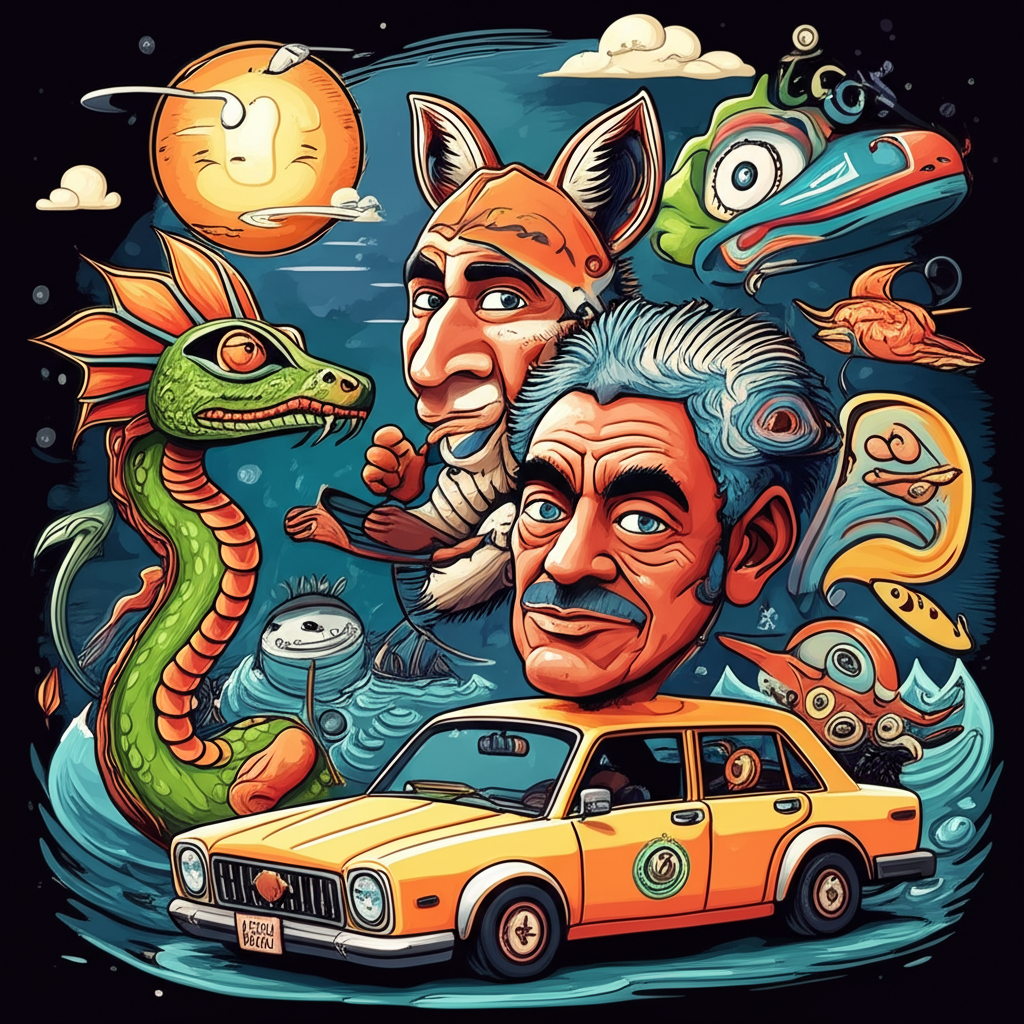
The world, for ancient peoples, was a vibrant tapestry woven from the threads of the natural world and the unseen forces they perceived. Myths and legends served as a crucial part of their understanding, offering explanations for the inexplicable and providing frameworks for navigating life. Among the rich tapestry of such traditional narratives, we find tales that resonate with themes of transformation, the primal power of nature, and the interplay of chaos and order. This article delves into a compelling confluence of these ancient narratives, exploring the potential echoes of a trickster figure, the formidable Horned Serpent, and the vast, mysterious Inuit Seas.
Origins and Cultural Background: Whispers from the Arctic
This narrative draws from the rich oral traditions of the Inuit people, indigenous to the Arctic regions of Greenland, Canada, and Alaska. These stories emerged from a time when life was intimately tied to the harsh, yet beautiful, Arctic environment. For the Inuit of this era, the world was not merely a physical space but a realm imbued with spirits and forces that shaped their existence. The vast, ice-bound landscapes, the unpredictable weather, the bounty and peril of the sea – all were seen as animated by powers beyond human control. Survival depended on a deep understanding of these forces, often expressed through carefully observed natural phenomena and the creation of elaborate myths. Their worldview was animistic, attributing life and spirit to all things, from the smallest pebble to the mightiest whale. This perspective fostered a profound respect for the natural world, as well as a keen awareness of its potential dangers.
Character/Creature Description: The Shifting Form and the Submerged Power
Within these traditional Inuit narratives, we can discern echoes of figures that embody certain archetypal qualities. While not a direct one-to-one mapping, the characteristics of the Coyote as a trickster figure, a being known for its cleverness, mischievousness, and often disruptive nature, can be seen in various shape-shifting spirits or powerful beings that challenge the status quo. The Coyote, in many North American Indigenous traditions, is a primal force, sometimes benevolent, sometimes malevolent, but always a catalyst for change. Its symbolic attributes lie in its ability to outwit others, its adaptability, and its role in blurring the lines between the sacred and the mundane, the natural and the supernatural.
The Horned Serpent, a powerful and ancient archetype found in many mythologies worldwide, represents a potent, often subterranean or aquatic, force. Its symbolism is multifaceted, encompassing creation, destruction, wisdom, and the primal energies of the earth and water. The horns often signify power and authority, while its serpentine form speaks to fluidity, transformation, and a connection to the underworld or the deep, unknown realms. In the context of the Inuit, this archetype might manifest as a powerful sea creature, a guardian of the depths, or a force that commands the tides and storms.
The Inuit Seas themselves are not merely a setting but a living entity in these stories. They represent the vastness of the unknown, the source of sustenance and life, but also a realm of immense danger and mystery. The icy waters, the crushing pressure, the unseen creatures that dwell within – all contribute to a sense of awe and trepidation. The sea is a constant presence, shaping the lives and beliefs of the people who depend on its resources.
Main Story / Narrative Retelling: The Dance of the Trickster and the Deep
Imagine a time when the world was still finding its form, when the great ice floes groaned and shifted, and the Inuit people lived in close harmony with the rhythms of the Arctic. In this era, whispers of a being, perhaps akin to the clever Coyote, moved through the settlements. This trickster was not malicious in the way we might understand it today, but rather a force of playful disruption, a being that delighted in testing boundaries and challenging the established order. It might appear as a lone wolf, its eyes glinting with ancient knowledge, or a gust of wind that carries secrets from afar.
One day, this trickster, restless and curious, found itself drawn to the edge of the vast, dark Inuit Seas. The waters, restless and deep, held a power that even the trickster found intriguing. It was said that deep within these frigid depths resided a creature of immense power, the Horned Serpent, a being that commanded the very currents and the moods of the ocean. Some tales spoke of its scales shimmering with the iridescence of the aurora borealis, its horns like jagged icebergs, and its eyes holding the cold, ancient wisdom of the sea.
The trickster, ever eager to test its wit, decided to engage this formidable entity. Perhaps it sought to steal a treasure from the Serpent’s hoard, or simply to prove its own cleverness against such a primal force. The encounter was not one of physical combat, but a battle of wits and will. The trickster might have used its shape-shifting abilities, appearing as a sealskin cloak to lure the Serpent, or as a cunning raven to distract it. It might have whispered riddles into the wind, hoping to ensnare the Serpent’s ancient mind.
The Horned Serpent, in its own way, was a guardian of balance. It understood the delicate equilibrium of the Arctic world. While it could unleash devastating storms and tidal waves, it also ensured the bounty of the seas. The trickster’s games, however, threatened to upset this balance. Perhaps the trickster’s actions caused the fish to flee, or the ice to crack prematurely, endangering the human settlements.
The Serpent would then rise from the depths, its form immense and awe-inspiring. It would not necessarily seek to destroy the trickster, but to teach it a lesson about the consequences of unchecked disruption. The Serpent’s power was not in brute force, but in its inherent connection to the natural order. It might have shown the trickster visions of the suffering caused by its meddling, or demonstrated the immense responsibility that comes with wielding such power.
In some versions of these ancient narratives, the trickster, humbled by the Serpent’s wisdom and the raw power of the sea, would retreat, leaving the Serpent to resume its silent vigil. In others, the trickster might have learned a valuable lesson, becoming a slightly more responsible, albeit still mischievous, force in the world. The encounter would leave an indelible mark, a story passed down through generations, reminding people of the delicate balance between the forces of nature and the consequences of human (or trickster) actions. The echoes of the trickster’s playful interference and the Serpent’s ancient power would forever be linked to the vast, inscrutable Inuit Seas.
Symbolism and Meaning: The Dance of Nature’s Forces
To the ancient Inuit, these stories likely represented a profound understanding of their world. The trickster figure, in its various manifestations, could symbolize the unpredictable nature of life, the constant need for adaptability, and the inherent chaos that exists alongside order. It might have served as a cautionary tale about the dangers of overstepping boundaries or a reminder that even the most powerful can be outwitted, albeit with potential consequences.
The Horned Serpent, as a guardian of the deep, could represent the immense, untamed power of nature, particularly the sea, which was both the source of life and a constant threat. Its presence symbolized the mysteries that lay beneath the surface, the unseen forces that governed their world, and the ancient wisdom inherent in the natural order. It could also represent a primal, chthonic energy, connected to the earth and its hidden powers.
The interplay between the trickster and the Serpent would then symbolize the ongoing tension between chaos and order, disruption and balance, the known and the unknown. These narratives helped the Inuit to understand their place in a world where natural forces were paramount, fostering a sense of respect and a recognition of the interconnectedness of all things. They provided a framework for understanding the cyclical nature of life and death, bounty and scarcity, and the importance of maintaining harmony with the environment.
Modern Perspective: Echoes in Contemporary Arts
Today, these ancient myths and archetypes continue to resonate in various forms of modern storytelling. The trickster figure, with its inherent ambiguity and ability to subvert expectations, remains a popular character in literature, film, and video games, often representing rebellion, change, or a questioning of authority. The Horned Serpent, as a powerful mythical creature, frequently appears in fantasy genres, embodying ancient power, primal magic, or the dangers of the deep.
In academic circles, these stories are studied for their anthropological, cultural, and psychological insights. They are examined for the ways in which they reveal the worldview of ancient peoples, their understanding of the cosmos, and their social structures. Scholars of mythology and folklore analyze the recurring themes and archetypes, drawing connections between seemingly disparate traditions and exploring the universal human need to make sense of the world through narrative. Cultural studies often explore how these traditional stories are adapted and reinterpreted by contemporary artists, reflecting ongoing cultural dialogues and the enduring power of these ancient narratives.
Conclusion: A Legacy of Imagination
It is crucial to reiterate that these narratives are ancient stories, born from the rich cultural heritage and the imaginative spirit of the Inuit people. They are not to be interpreted as literal truths or divine pronouncements. As Muslims, we recognize that only Allah (God) is the true Creator and Sustainer of all that exists, the ultimate source of power and knowledge.
However, by exploring these traditional tales, we gain a valuable understanding of human history, cultural diversity, and the enduring power of storytelling. These myths serve as windows into the minds of our ancestors, revealing their struggles, their hopes, and their profound connection to the natural world. They remind us of the boundless capacity of human imagination and the rich tapestry of narratives that shape our collective understanding of existence. The echoes of the trickster, the Serpent, and the Inuit Seas are not calls to belief, but invitations to appreciate the depth and beauty of human cultural heritage.





